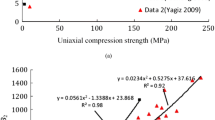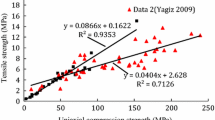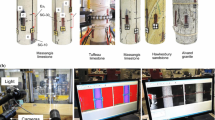Abstract
In this study, based on true-triaxial compression tests, five typical post-peak brittle characteristics are summarized, and the stress dependence is observed. Next, the quantitative description of this stress-dependent post-peak brittle characteristic is theoretically discussed. Then, combining the cluster analysis and the artificial recognition results on the brittleness, a new quantitative universal classification method based on stress-dependent brittleness is proposed, which is suitable for numerous hard rock types, with fewer parameters involved. Through implemented code and application to the actual field case, it is found that this stress-dependent post-peak characteristics model causes the higher energy concentration to occur at a deeper location comparing to traditional stress-independent models. The significance of the hard rock engineering is discussed, and the results indicate that it is necessary to consider the true-triaxial stress state of the rock mass and the influence of intermediate and minor principal stresses to the post-peak behaviour cannot be neglected. Finally, it is suggested to adopt the stress-dependent post-peak characteristic model in the design process of hard rock engineering, particularly for cases under high stress or severe engineering hazards such as rockbursts, which require more accurate calculation and prediction with lower error allowance.




























Similar content being viewed by others
References
Alonso E, Alejano LR, Varas F, Fdez-Manin G, Carranza-Torres C (2003) Ground response curves for rock masses exhibiting strain-softening behaviour. Int J Numer Anal Meth Geomech 27(13):1153–1185
Amann F, Button EA, Evans KF, Gischig VS, Blümel M (2011) Experimental study of the brittle behaviour of clay shale in rapid unconfined compression. Rock Mech Rock Eng 44(4):415–430
Amari SI (1993) Backpropagation and stochastic gradient descent method. Neurocomputing 5(4–5):185–196
Aubertin M, Gill DE, Simon R (1994) On the use of the brittleness index modified (BIM) to estimate the post peak behaviour of rocks. In 1st North American Rock Mechanics Symposium. American Rock Mechanics Association
Brown ET, Bray JW, Ladanyi B, Hoek E (1983) Ground response curves for rock tunnels. J Geotech Eng 109(1):15–39
Byerlee JD (1968) Brittle-ductile transition in rocks. J Geophys Res 73(14):4741–4750
Crowder JJ, Bawden WF (2004) Review of post peak parameters and behaviour of rock masses: current trends and research. Rocnews, fall
Dreiseitl S, Ohno-Machado L (2002) Logistic regression and artificial neural network classification models: a methodology review. J Biomed Inform 35(5–6):352–359
Eberhardt E, Stead D, Coggan JS (2004) Numerical analysis of initiation and progressive failure in natural rock slopes—the 1991 Randa rockslide. Int J Rock Mech Min Sci 41(1):69–87
Edelbro C (2009) Numerical modelling of observed fallouts in hard rock masses using an instantaneous cohesion-softening friction-hardening model. Tunn Undergr Space Technol 24(4):398–409
Feng XT, Pan PZ, Zhou H (2006) Simulation of the rock microfracturing process under uniaxial compression using an elasto-plastic cellular automaton. Int J Rock Mech Min Sci 43(7):1091–1108
Feng XT, Hudson JA (2011) Rock engineering design. CRC Press
Feng XT, Zhang X, Kong R, Wang G (2016) A novel mogi type true-triaxial testing apparatus and its use to obtain complete stress–strain curves of hard rocks. Rock Mech Rock Eng 49(5):1649–1662
Feng XT, Kong R, Yang C, Zhang X, Wang Z, Han Q, Wang G (2019a) A Three-Dimensional Failure Criterion for Hard Rocks Under True-triaxial Compression. Rock Mech Rock Eng 1–9
Feng XT (2017) Rockburst: mechanisms, monitoring, warning, and mitigation. Butterworth-Heinemann
Feng XT, Yao ZB, Li SJ, Wu SY, Yang CX, Guo HS, Zhong S (2018a) In situ observation of hard surrounding rock displacement at 2400-m-deep tunnels. Rock Mech Rock Eng 51(3):873–892
Feng XT, Xu H, Qiu SL, Li SJ, Yang CX, Guo HS, Gao YH (2018b) In situ observation of rock spalling in the deep tunnels of the China Jinping underground laboratory (2400 m Depth). Rock Mech Rock Eng 51(4):1193–1213
Feng XT, Guo HS, Yang CX, Li SJ (2018c) In situ observation and evaluation of zonal disintegration affected by existing fractures in deep hard rock tunneling. Eng Geol 242:1–11
Feng XT, Zhou YY, Jiang Q (2019a) Rock mechanics contributions to recent hydroelectric developments in China. J Rock Mech Geotech Eng
Feng XT, Kong R, Zhang X, Yang C (2019b) Experimental Study of Failure Differences in Hard Rock Under True-triaxial Compression. Rock Mech Rock Eng 1–14
Feng XT, Wang Z, Zhou Y, Yang C, Pan PZ, Kong R (2021a) Modelling three-dimensional stress-dependent failure of hard rocks. Acta Geotech 16(6):1647–1677
Feng XT, Zhao J, Wang Z, Yang C, Han Q, Zheng Z (2021b) Effects of high differential stress and mineral properties on deformation and failure mechanism of hard rocks. Can Geotech J 58:411–426
Feng XT, Pan PZ, Wang Z, Zhang Y (2021c) Development of Cellular Automata Software for Engineering Rockmass Fracturing Processes. in International Conference of the International Association for Computer Methods and Advances in Geomechanics. Torino, Italy: Springer International Publishing
Gao YH, Feng XT, Zhang XW, Feng GL, Jiang Q, Qiu SL (2018) Characteristic stress levels and brittle fracturing of hard rocks subjected to true-triaxial compression with low minimum principal stress. Rock Mech Rock Eng 51(12):3681–3697
Hajiabdolmajid V, Kaiser PK, Martin CD (2002) Modelling brittle failure of rock. Int J Rock Mech Min Sci 39(6):731–741
Hajiabdolmajid V, Kaiser P (2003) Brittleness of rock and stability assessment in hard rock tunneling. Tunn Undergr Space Technol 18(1):35–48
Hill R (1998) The mathematical theory of plasticity (Vol. 11). Oxford university press
Hoek E, Brown ET (1997) Practical estimates of rock mass strength. Int J Rock Mech Min Sci 34(8):1165–1186
Hoek E, Kaiser PK, Bawden WF (2000) Support of underground excavations in hard rock. CRC Press
Hudson JA, Brown ET, Fairhurst C (1971) Optimizing the control of rock failure in servo-controlled laboratory tests. Rock Mech 3(4):217–224
Jansen DC, Shah SP (1997) Effect of length on compressive strain softening of concrete. J Eng Mech 123(1):25–35
Jiang Q, Feng XT, Xiang TB, Su GS (2010) Rockburst characteristics and numerical simulation based on a new energy index: a case study of a tunnel at 2,500 m depth. Bull Eng Geol Env 69(3):381–388
Joshi A, Kaur R (2013) A review: Comparative study of various clustering techniques in data mining. Int J Adv Res Comp Sci Software Eng 3(3)
Kodinariya TM, Makwana PR (2013) Review on determining number of Cluster in K-Means Clustering. Int J 1(6):90–95
Lee YK, Pietruszczak S (2008) A new numerical procedure for elasto-plastic analysis of a circular opening excavated in a strain-softening rock mass. Tunn Undergr Space Technol 23(5):588–599
Mogi K (1972) Effect of the triaxial stress system on fracture and flow of rocks. Phys Earth Planet Inter 5:318–324
Mei W, Li M, Pan PZ, Pan J, Liu K (2021) Blasting induced dynamic response analysis in a rock tunnel based on combined inversion of Laplace transform with elasto-plastic cellular automaton. Geophys J Int 225:699–710
Mei W, Xia Y, Pan PZ, Li M, Tan S, Zhang Y (2022) Transient responses of deep-buried unlined tunnels subjected to blasting P wave. Comput Geotech 146:104729
Pan PZ, Feng XT, Hudson JA (2009) Study of failure and scale effects in rocks under uniaxial compression using 3D cellular automata. Int J Rock Mech Min Sci 46(4):674–685
Pan P-Z, Feng X-T, Zhou H (2012) Development and applications of the elasto-plastic cellular automaton. Acta Mech Solida Sin 25(2):126–143
Park KH, Kim YJ (2006) Analytical solution for a circular opening in an elastic–brittle–plastic rock. Int J Rock Mech Min Sci 43(4):616–622
Read H, Hegemier GA (1984) Strain softening of rock, soil and concrete—a review article. Mech Mater 3(4):271–294
Ross JV, Lewis PD (1989) Brittle-ductile transition: Semi-brittle behaviour. Tectonophysics 167(1):75–79
Rummel F, Fairhurst C (1970) Determination of the post-failure behaviour of brittle rock using a servo-controlled testing machine. Rock Mech 2(4):189–204
Sharan SK (2003) Elastic–brittle–plastic analysis of circular openings in Hoek-Brown media. Int J Rock Mech Min Sci 40(6):817–824
Vermeer PA, De Borst R (1984) Non-associated plasticity for soils, concrete and rock. HERON 29(3):1984
Wawersik WR, Fairhurst CH (1970) A study of brittle rock fracture in laboratory compression experiments. In Int J Rock Mech Min Sci Geomech Abs 7(5):561–575 Pergamon
Wawersik WR, Brace WF (1971) Post-failure behaviour of a granite and diabase. Rock Mech 3(2):61–85
Wawersik WR, Olsson WA, Holcomb DJ, Rudnicki JW, Chau KT (1990) Localization of deformation in brittle rock: Theoretical and laboratory investigations (No. SAND-90–0507C; CONF-9006122–2). Sandia National Labs., Albuquerque, NM (USA)
Yang CX, Wu YH, Hon T (2010) A no-tension elastic–plastic model and optimized back-analysis technique for modelling nonlinear mechanical behaviour of rock mass in tunneling. Tunn Undergr Space Technol 25(3):279–289
Zhao XG, Cai M (2010a) A mobilized dilation angle model for rocks. Int J Rock Mech Min Sci 47(3):368–384
Zhao XG, Cai M (2010b) Influence of plastic shear strain and confinement-dependent rock dilation on rock failure and displacement near an excavation boundary. Int J Rock Mech Min Sci 47(5):723–738
Zhao J, Feng XT, Zhang XW, Zhang Y, Zhou YY, Yang CX (2018) Brittle-ductile transition and failure mechanism of Jinping marble under true-triaxial compression. Eng Geol 232:160–170
Acknowledgements
This work was funded by the National Natural Science Foundation of China (Grant Nos. 52125903, 51621006). We would like to thank Key Laboratory of Ministry of Education on Safe Mining of Deep Metal Mines, Northeastern University for giving us the opportunities to conduct the experimental and simulating tests. Appreciation is extended to all the teachers and staffs here.
Author information
Authors and Affiliations
Corresponding author
Rights and permissions
Springer Nature or its licensor holds exclusive rights to this article under a publishing agreement with the author(s) or other rightsholder(s); author self-archiving of the accepted manuscript version of this article is solely governed by the terms of such publishing agreement and applicable law.
About this article
Cite this article
Wang, Z., Pan, PZ. & Yang, S. Quantitative description of stress-dependent post-peak brittle characteristics and numerical implementation. Bull Eng Geol Environ 81, 451 (2022). https://doi.org/10.1007/s10064-022-02919-1
Received:
Accepted:
Published:
DOI: https://doi.org/10.1007/s10064-022-02919-1




